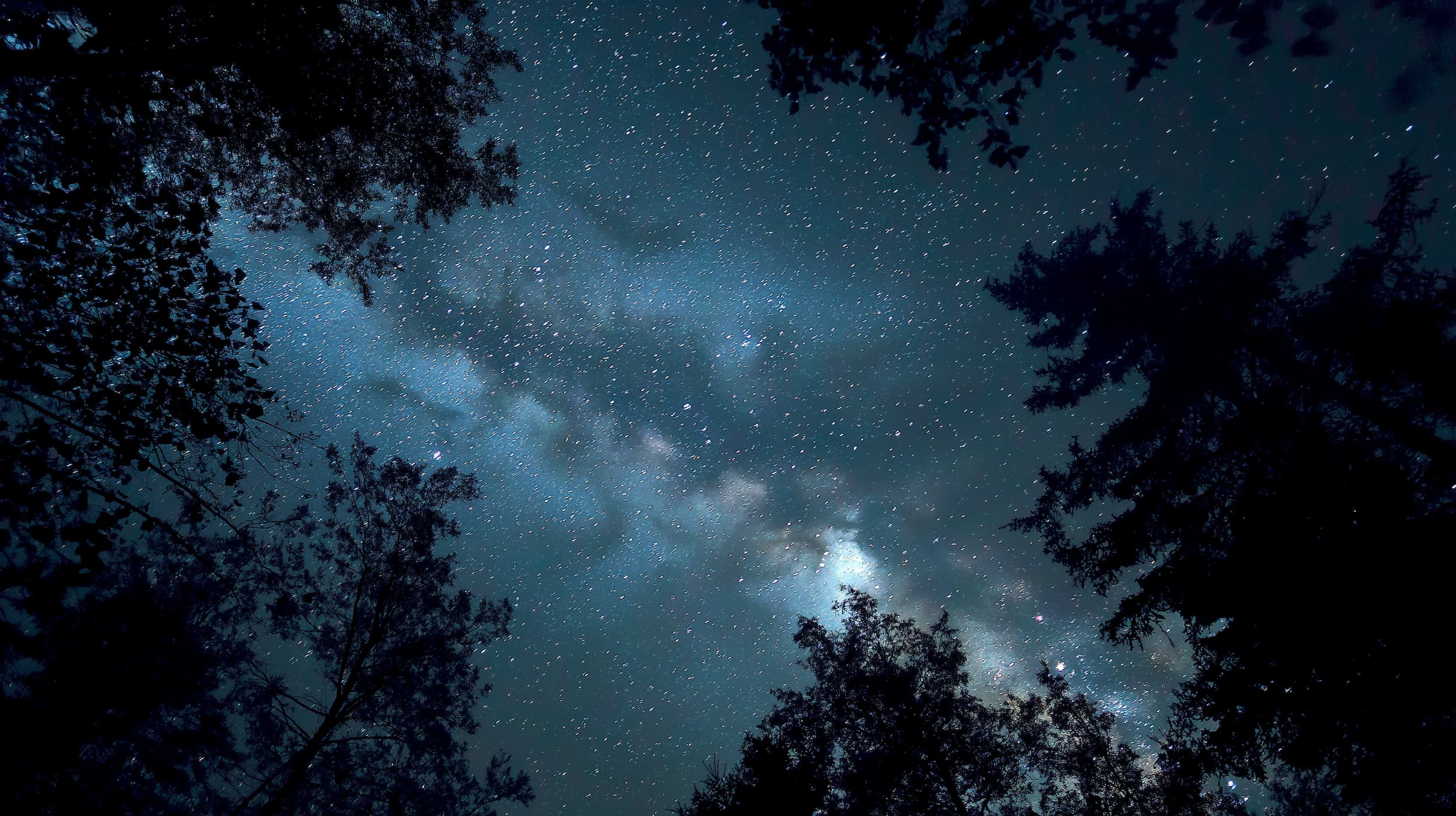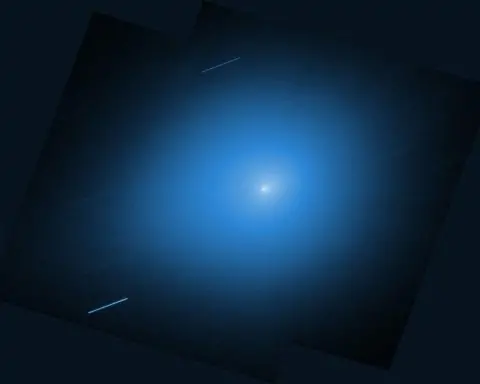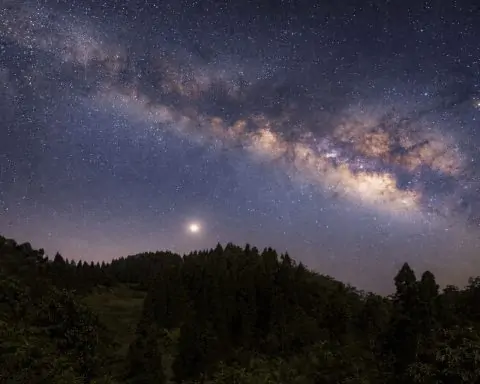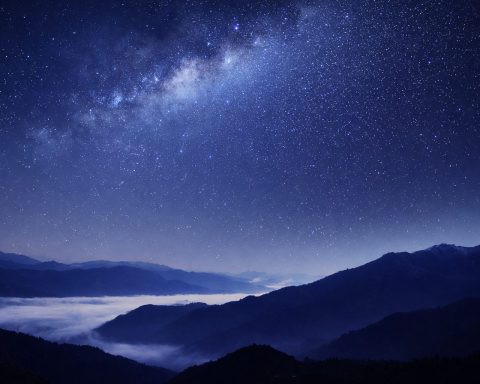- Orionid Meteor Shower begins: Earth enters the Orionid stream (from Halley’s Comet) on Oct. 2 [1]. The shower is active Oct. 2–Nov. 12 (peak ~Oct. 20–21) when skywatchers might see ~10–20 shooting stars per hour under dark skies [2] [3]. (Early Oct nights will have only a few meteors per hour [4].)
- Draconid Meteor Shower (Oct 8 peak): The minor Draconids run Oct. 6–10, peaking Oct. 8 [5]. NASA notes the Draconids can produce “up to 10 meteors per hour” at peak [6], though the nearby full Harvest Moon (Oct. 6) will drown out all but the brightest. Late-evening observing in dark sky (with the bright Moon hidden) gives the best chance.
- Harvest Supermoon (Oct 6): The full “Harvest” Moon on Oct. 6 is also a supermoon – the Moon’s perigee (closest approach). It will appear ~14% larger and ~30% brighter than average [7], dominating the sky. (This is the first of three 2025 supermoons.)
- Planets & Deep-Sky Highlights: On Oct. 2, the Andromeda Galaxy (M31) climbs to its zenith at midnight [8], and dwarf planet Ceres reaches opposition (closest to Earth) [9], shining at about magnitude +7.7 (within reach of binoculars). Look for a bright Andromeda smudge near Cassiopeia’s “W” straight overhead. Venus blazes in the pre-dawn eastern sky (NASA: Venus is the “Morning Star” in Oct. [10]); Saturn and Jupiter will be visible after sunset toward the south/east.
- Northern Lights & Space Weather: NOAA forecasters have warned of strong geomagnetic storms around Oct. 2 [11]. A G3 (“strong”) storm was predicted Oct. 2 due to a fast solar wind stream [12]. Space.com reports NOAA’s alert: “geomagnetic storm conditions are likely to persist… That means the aurora could once again dip farther south than usual” [13]. In other words, the Northern Lights may extend to unusually low latitudes late on Oct. 2. (By Oct. 3, NOAA expects activity to subside to G1–G2 levels.) Aurora-hunters in Poland and other mid-northern latitudes should watch the late-evening sky to the north.
- Solar Activity: NOAA also forecasts moderate solar activity on Oct. 2–4 with a slight chance of an X-class flare [14]. Geomagnetic conditions are expected “unsettled to active” on Oct. 2–3 [15] – consistent with the storm watch. In short, the Sun is expected to be lively, so radio disruptions or vivid auroras are possible.
- Satellites & Launches: On Oct. 3 a SpaceX Falcon 9 will launch a batch of Starlink internet satellites from Vandenberg AFB [16]. (This is a daytime launch for Europe/Asia, so it won’t be a naked-eye evening sight, but it’s one of the few planned launches in early October.) At night, the International Space Station and Starlink trains are visible overhead on their usual schedules (check a satellite tracker for your location).
- Other Skywatch Tips: With the Moon brightening the sky after Oct. 6, early October is actually the prime time to spot the zodiacal light – a faint “false dawn” glow along the eastern horizon after midnight in the Northern Hemisphere. The zodiacal light is best seen in late summer/early fall [17] when the ecliptic is steep. From a dark site in Poland on the nights around Oct. 2–3, look east in the 1–3 AM sky for a pyramid of soft light rising from the horizon [18].
Meteor Showers: Draconids & Orionids
Early October brings the Draconids and Orionids meteor showers. NASA’s skywatching notes explain that the Draconids (debris from comet 21P/Giacobini-Zinner) will streak through the sky Oct. 6–10 [19]. In a perfect dark sky the Draconids can reach “up to 10 meteors per hour,” but this year a bright full Moon on Oct. 6–7 will drown out most fainter meteors [20]. Observers should try to block the Moon (for example, by hiding it behind a tree or building) if possible.
After the Draconids, the Orionid meteor shower ramps up. Space.com reports “the Orionid meteor shower has arrived!” and advises skywatchers to “look up on the nights between Oct. 2 to Nov. 12” to catch the streaking debris of Halley’s Comet [21]. The Orionids peak around Oct. 20–21, when NASA predicts a “spectacular show” with roughly 20 meteors per hour under ideal dark skies [22]. (American Meteor Society forecasts cite a slightly lower rate, peaking Oct. 22 [23].) For now (Oct. 2–3), only a few Orionids per hour will be visible, and moonlight from earlier October nights will further suppress the shower. Still, the constellation Orion (in the southeast pre-midnight) is the radiant – meteors will appear to radiate from that region but can fly all over the sky. The best time to watch is in the hour or two before dawn, when Orion is highest.
“The Orionid meteors sparkle across the night sky,” NASA’s JPL explains [24]. Experts recommend finding a dark, open sky and waiting at least 30 minutes for dark adaptation. A recliner and red flashlight can help. Remember, meteor showers often reward patience more than cameras: the eye-popping ones are unpredictable!
Planets, Moon & Deep-Sky Sights
October offers a rich planetary and deep-sky display. In the pre-dawn east, Venus shines brilliantly – NASA notes that “Venus continues to be the ‘Morning Star’ in the east before dawn” [25]. Through October it will climb higher each week. In the evening, Saturn rises soon after sunset (visible all night long) and Jupiter will rise by midnight. (EarthSky notes that in early October “Saturn is visible most of the night” and that Mercury and Mars hug the western twilight [26], but these latter two are very low and fading.)
Notably, on Oct. 2 the dwarf planet Ceres reaches opposition (opposite the Sun) [27]. At this time Ceres – largest asteroid-belt object – shines at about magnitude +7.7, bright enough for binoculars or a small telescope. It will be near the star Eta Ceti, low in the southeast after dark. Also on Oct. 2, the Andromeda Galaxy (M31) climbs to its highest point at around midnight [28]. Under truly dark skies it looks like a faint oval, but even from suburban Warsaw it will appear as a misty patch with binoculars. As NatGeo reports, Oct. 2 is an “ideal night to seek out” both M31 and Ceres [29]. (Bring a star chart or phone app to find Cassiopeia’s “W” and then hop to M31 by counting stars in Perseus.)
The Moon is a bright feature early in the month. Although no lunar or solar eclipses occur on Oct. 2–3, note that Oct. 6 is the full Harvest Moon (coinciding with perigee). This “supermoon” will rise at sunset and stay bright through the night [30]. (In fact, NASA’s October guide explains the full moon on Oct. 6 can be up to 14% larger than average [31].) After that, the Moon moves on to encounter Pleiades on Oct. 9–10, but that lies outside our focus dates.
Space Weather & Aurora Alerts
Solar activity and geomagnetic storms will be headline events. NOAA’s Space Weather Prediction Center issued a G3 (Strong) geomagnetic storm watch for Oct. 2 [32], due to high-speed solar wind from a coronal hole. SpaceWeatherLive and NOAA data indicate a Kp index climbing to ~6 (G2)–7 (G3) on Oct. 1–2, meaning vivid auroras are possible at high latitudes and even mid-latitudes. In fact, Space.com reports NOAA warned “the aurora could once again dip farther south than usual” [33]. For Poland (latitude ~52°N), this means a chance of seeing greenish curtains on the northern horizon late on Oct. 2 or in the very early hours Oct. 3. Conditions will depend on remaining solar wind and the interplanetary magnetic field; if the storm remains strong, Norway/Sweden could see a spectacular show.
According to NOAA’s daily bulletin, solar activity is expected to remain moderate on Oct. 2–4 with a slight chance of an X-class flare [34]. Even without a flare, the continuing high-speed wind should keep conditions “unsettled to active” on Oct. 2–3 [35]. (That aligns with NOAA’s earlier alert of G1–G2 storm levels for Oct. 3). Shortwave radio operators should be alert for minor blackouts (R1–R2 levels), but full outages are unlikely. In summary: NOAA experts advise skywatchers to check the Aurora forecast or local geomag indices. If Kp climbs above 5–6, northern lights might appear as low as Hungary or Poland’s northern provinces. Keep a wide-angle camera ready!
“G3 (Strong) geomagnetic storming is expected through Oct 2,” warned NOAA on Oct. 2 [36]. In practice, this means skywatchers in Europe and North America should scan the northern sky after dark. If you’re willing to drive to a darker site (away from city glow), your chances improve significantly.
Satellites and Launches
Nocturnal skywatchers may also glimpse human-made objects. The International Space Station passes overhead several times per night; on Oct. 2–3 its bright “train” should be visible in pre-dawn and dusk skies (check a satellite tracker app for exact times over Warsaw). The large Starlink constellation will produce occasional satellite trains after dusk as well.
In daylight-space events, SpaceX plans a Falcon 9 launch of Starlink satellites on Oct. 3 (09:00 EDT/13:00 UTC) [37]. This launch from Vandenberg (California) will loft dozens of Internet satellites. It will occur well before sunset in Europe, so the rocket plume might catch the sunlight for an early-evening ground observer. (Even if not seen, it’s one of the few scheduled launches in the Oct. 2–3 window.) Other launches in October include Blue Origin’s New Shepard (suborbital) and SpaceX Starship later in the month, but none fall exactly on Oct. 2–3.
Astronomy buffs should also note the approach of Comet C/2025 R2 (SWAN), a newly discovered visitor. Space.com reports that by mid-October R2/SWAN may climb into our evening sky, possibly becoming visible to the naked eye [38]. It’s currently too near the Sun to see, but by late October it might be found low in the west after sunset. (Keep an eye on comet blogs if you’re interested – it’s not a target on Oct. 2–3 yet, but is one to watch as October progresses.)
Finally, don’t forget the zodiacal light: around now in the Northern Hemisphere, a faint triangular glow can rise in the eastern sky before dawn. As EarthSky notes, late summer and early fall are the best seasons for spotting this ghostly “false dawn” [39]. If skies are clear in the early morning hours of Oct. 2–3, look east-southeast just before twilight for the zodiacal light pyramid – a sight unique to clean, dark horizons.
Observational Tips
- Meteor watching: Lie back, use a reclining chair, and give your eyes at least 30 minutes to dark-adapt. Shield bright lights (smartphones on red mode). For the Orionids on Oct. 2–3, face east-southeast after midnight – Orion will be ascending. For Draconids on Oct. 6–8, face north after twilight (radiant is in Draco).
- Aurora hunting: Check NOAA or local space weather resources for real-time Kp-index (G2 or higher). If sky is clear and storm forecasts hold, find a dark spot facing north. A good strategy is to monitor geomagnetic indices (e.g. NOAA’s “Penticton A-index”) and go out when they spike. Cameras should be set wide and slow (tripod, 10–20 s exposure at high ISO).
- Planet spotting: Use a stargazing app to identify bright objects. Venus will be unmistakable in the predawn sky. Saturn will appear as a bright “star” a few degrees above the eastern horizon after sunset. Look for a yellowish hue; binoculars will reveal tiny ring hints. Jupiter will rise near 1 AM local time, very bright and whitish. The large gibbous Moon on Oct. 6 will wash out fainter objects, so prime deep-sky observing is best done Oct. 2–5 before Moonrise.
- Galaxies & comets: Binoculars or a small telescope on Oct. 2–3 will show the Andromeda Galaxy very well (near Cassiopeia). If you can find Eta Ceti in Cetus, Ceres should be just above it at magnitude ~7.7 [40] (binocular-level). Be patient – Ceres moves slowly night by night.
In summary, October 2–3, 2025 offers a true skywatching smorgasbord: a budding meteor shower display, a brilliant planets-and-galaxies lineup, and even space weather drama with potential Northern Lights. Keep your eyes peeled, check the forecasts, and enjoy the cosmic show. As space weather forecaster NOAA put it, “aurora could once again dip farther south than usual” [41] – so October could start with a bang for northern skygazers.
Sources: NASA, NOAA/Space Weather Prediction Center, Space.com, NatGeo, EarthSky, AMS, WTOP, and related astronomy news [42] [43] [44] [45] [46].
References
1. www.space.com, 2. www.space.com, 3. science.nasa.gov, 4. www.amsmeteors.org, 5. www.nationalgeographic.com, 6. science.nasa.gov, 7. www.nationalgeographic.com, 8. www.nationalgeographic.com, 9. www.space.com, 10. wtop.com, 11. www.swpc.noaa.gov, 12. www.swpc.noaa.gov, 13. www.space.com, 14. www.spaceweatherlive.com, 15. www.spaceweatherlive.com, 16. www.space.com, 17. earthsky.org, 18. earthsky.org, 19. www.nationalgeographic.com, 20. science.nasa.gov, 21. www.space.com, 22. science.nasa.gov, 23. www.space.com, 24. science.nasa.gov, 25. wtop.com, 26. earthsky.org, 27. www.space.com, 28. www.nationalgeographic.com, 29. www.nationalgeographic.com, 30. www.nationalgeographic.com, 31. www.nationalgeographic.com, 32. www.swpc.noaa.gov, 33. www.space.com, 34. www.spaceweatherlive.com, 35. www.spaceweatherlive.com, 36. www.swpc.noaa.gov, 37. www.space.com, 38. www.space.com, 39. earthsky.org, 40. www.space.com, 41. www.space.com, 42. science.nasa.gov, 43. science.nasa.gov, 44. www.swpc.noaa.gov, 45. www.space.com, 46. www.space.com










